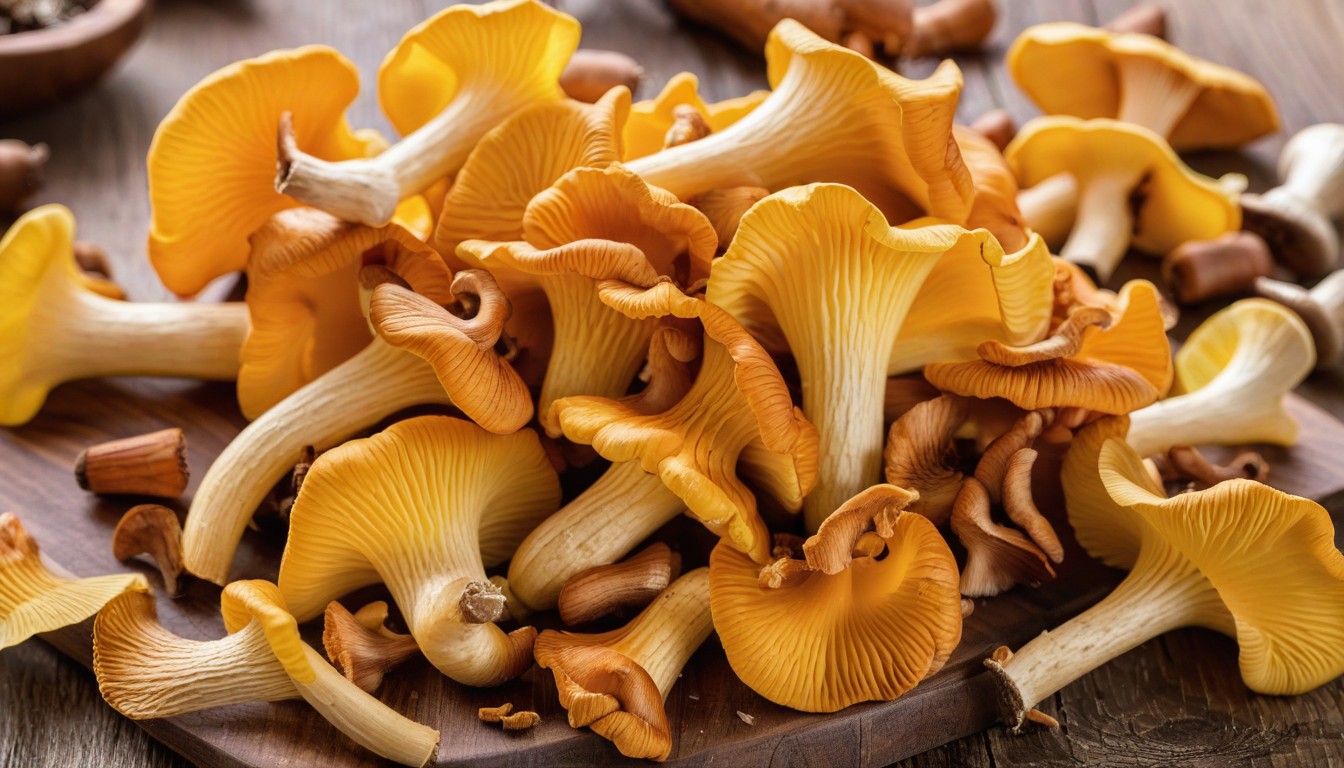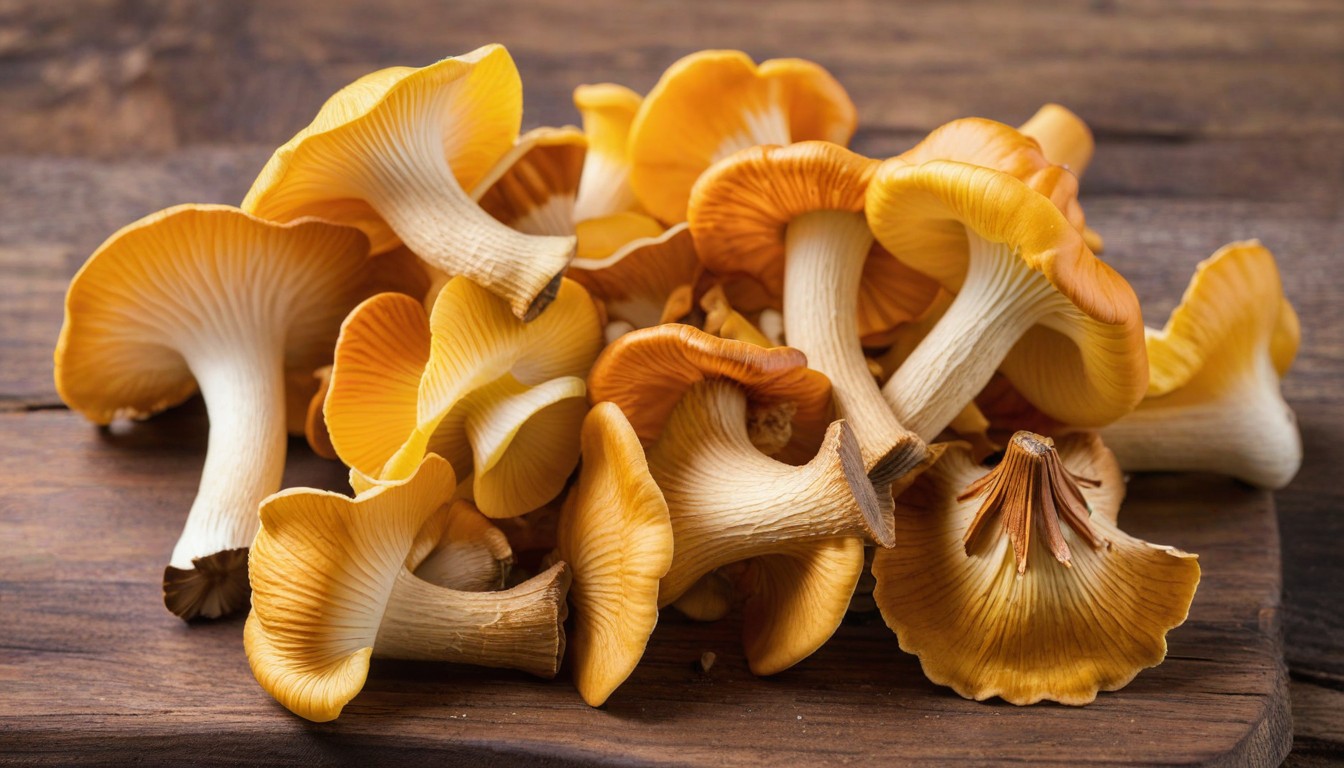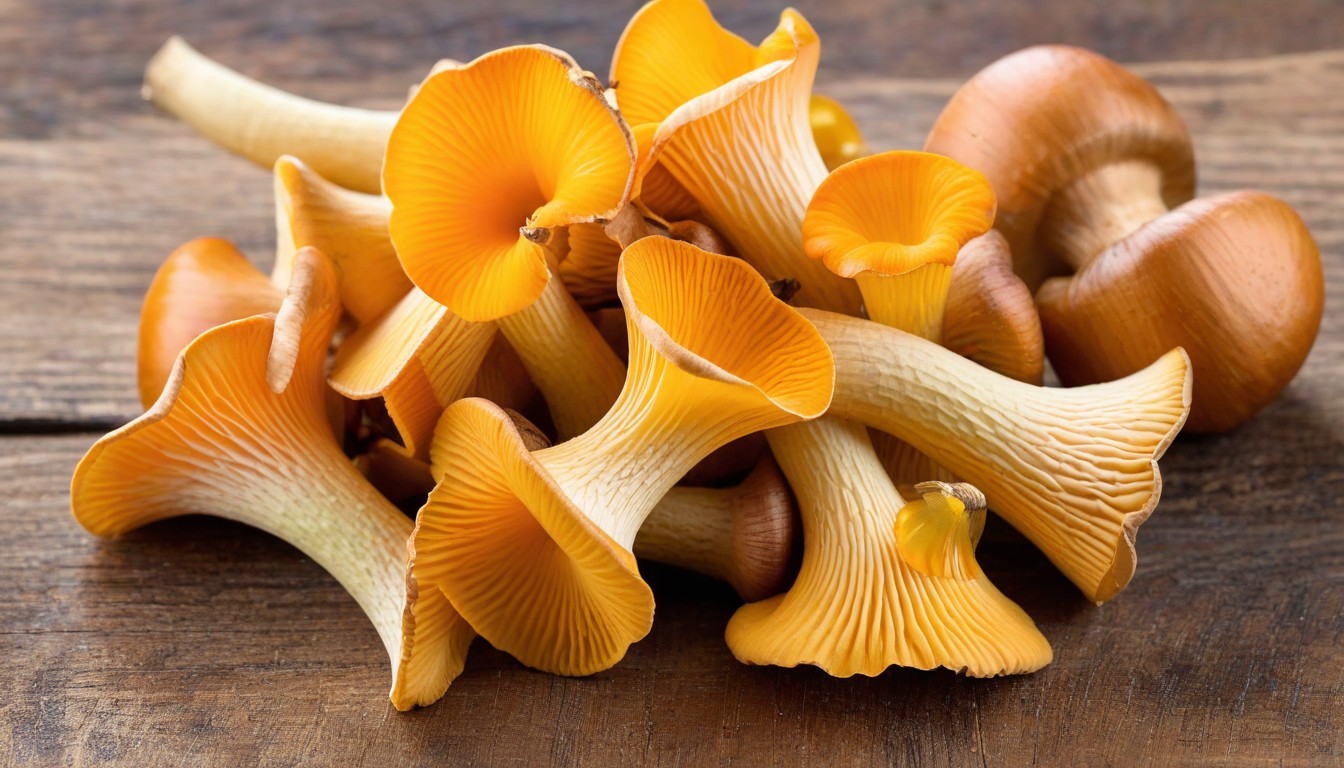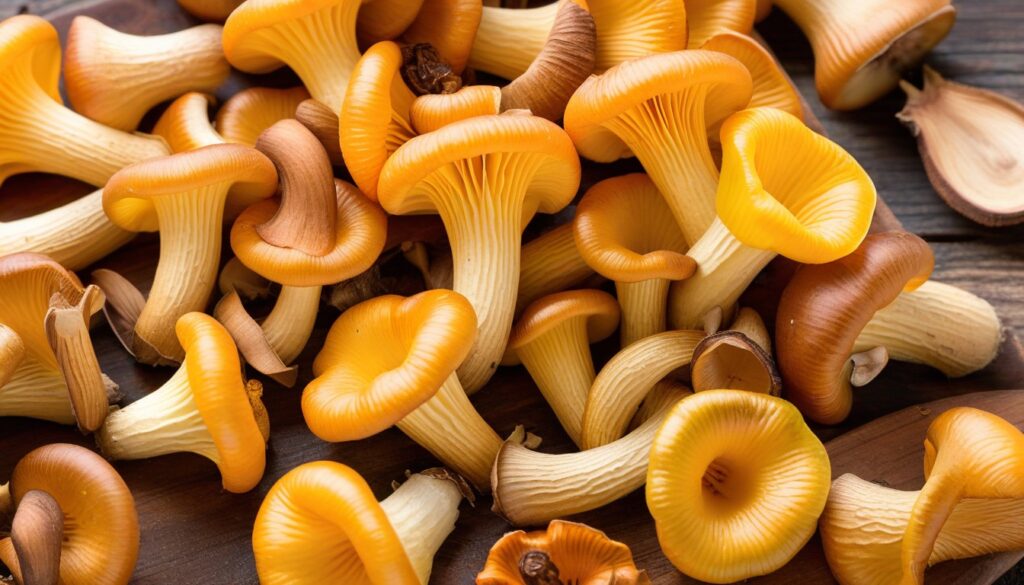Are you a mushroom lover looking for the perfect opportunity to forage for Chanterelle Mushrooms in Illinois? Look no further! In this comprehensive guide, we provide you with all the information you need to know about the natural habitat, seasonal availability, and best practices for foraging these prized mushrooms. Whether you’re a seasoned forager or a beginner, this guide will help you embark on a thrilling journey through the forests of Illinois in search of these delicious fungi.
Key Takeaways:
- Chanterelle Mushrooms are prized for their unique flavor and meaty texture.
- Their natural habitat in Illinois includes hardwood forests with moist, well-drained soil and ample shade.
- The prime season for foraging is from late spring to early fall.
- Proper identification and ethical foraging practices are crucial for successful and sustainable mushroom hunting.
- Chanterelles are versatile and can be used in a variety of gourmet dishes, and can also be preserved using drying, freezing, or pickling methods.
What are Chanterelle Mushrooms?
Chanterelle Mushrooms are highly prized in the culinary world for their delicate and distinctive flavor, as well as their beautiful golden or apricot color. These fungi have a slightly fruity aroma and a meaty texture, making them a favorite among chefs and foragers alike.
Their unique flavor is due to the presence of compounds called terpenes, which give them a complex and earthy taste. Chanterelles are a rich source of vitamin D, iron, and other essential nutrients, making them a healthy addition to any diet.
These mushrooms are trumpet or vase-shaped, with a distinct ridged or veined cap. Their vibrant golden or orange color and forked gills that extend down the stem make them easy to identify, although it’s always best to consult a field guide or expert if you’re unsure.
Natural Habitat of Chanterelle Mushrooms in Illinois
Chanterelle Mushrooms can be found in a variety of habitats throughout Illinois. These prized fungi thrive in hardwood forests, especially where oak and beech trees are prevalent. They typically grow in areas with moist, well-drained soil and ample shade, such as the forest floor. With their vibrant golden or apricot color, Chanterelles are easily spotted among the fallen leaves, making them a favorite among foragers.
It’s essential to know the natural habitat of Chanterelle Mushrooms to increase your chances of finding them. The following table provides an overview of the ideal conditions that Chanterelles prefer:
Habitat Conditions | Details |
|---|---|
Soil Type | Well-drained, loamy soil, rich in organic matter |
Tree Species | Oak and beech trees are most commonly associated with Chanterelles, but they can also grow near conifers and other hardwoods |
Shade | Chanterelles thrive in areas with ample shade and indirect sunlight |
Moisture | The soil should be moist, but not waterlogged. Look for areas near streams, rivers, or other bodies of water |
By understanding the natural habitat of Chanterelle Mushrooms, you can plan your foraging trips and increase your chances of finding these delicious fungi in the wild. Remember to always follow ethical and sustainable foraging practices and obtain any necessary permits before harvesting any mushrooms in Illinois.
When to Forage for Chanterelle Mushrooms in Illinois

Foraging for Chanterelle Mushrooms in Illinois is a seasonal affair. Although the peak season of Chanterelle Mushrooms is typically during the summer months, mushroom growth can be influenced by various factors such as the amount of rainfall and the temperature. Thus, the ideal time to forage these mushrooms is from late spring to early fall when the weather and soil conditions are just right.
Identifying Chanterelle Mushrooms in the Wild
Knowing how to identify Chanterelle Mushrooms is crucial before you start picking them. The golden, vase-like mushrooms have a distinct appearance that is easy to recognize if you know what to look for.
What to Look For | Description |
|---|---|
Color | Chanterelles are a vibrant golden or orange color |
Cap | The cap has a distinct ridged or veined appearance |
Gills | The gills are forked and extend down the stem |
Shape | The mushroom has a trumpet or vase-like shape |
If you’re unsure about the identification of a mushroom, don’t pick it. Some poisonous mushrooms have a similar appearance to Chanterelles. Consult a field guide or expert if you need additional help.
Popular Locations for Chanterelle Mushroom Foraging in Illinois

Chanterelle Mushrooms can be found in various forested areas across Illinois, but some locations are considered hotspots for foragers. The Shawnee National Forest is one such location, covering over 270,000 acres and offering a diverse range of ecosystems, including wooded hills, bluffs, and meandering rivers. Another great option is the Cache River State Natural Area, which boasts over 14,000 acres of hardwood forests, wetlands, and natural communities.
Starved Rock State Park is also a popular destination for Chanterelle Mushroom foraging. Located along the south bank of the Illinois River, the Park’s wooded canyons, cliffs, and streams provide an ideal habitat for Chanterelle growth.
When foraging in these locations, be sure to obtain the necessary permits, adhere to responsible foraging practices, and respect private property boundaries.
Foraging Tips and Best Practices
Foraging for Chanterelle Mushrooms can be a fun and rewarding experience, but it’s essential to follow ethical practices to ensure sustainability and protect the environment. Here are some tips and best practices to keep in mind:
- Obtain proper permits if required: In some areas, a permit may be required to forage for mushrooms. Check with local authorities to ensure you have all the necessary paperwork.
- Respect private property boundaries: If you’re foraging on private property, make sure you have the owner’s permission and respect any posted boundaries.
- Only take what you need: Harvest only the mushrooms you plan to use. Leave the rest to propagate and support the forest ecosystem.
- Mindful of other wildlife: Avoid harming other wildlife and disturbing the natural balance of the forest by being mindful of your surroundings.
- Avoid damaging the forest floor or disturbing other plants and mushrooms: Use care when harvesting and avoid damaging the forest floor or disturbing other plants and mushrooms in the area.
By following these best practices, you can ensure the sustainability of Chanterelle Mushrooms and help preserve the beauty of the forest for future generations to enjoy.
Culinary Uses for Chanterelle Mushrooms

Chanterelle Mushrooms are a highly sought-after ingredient in the culinary world, prized for their versatility and unique flavor. Their meaty texture and earthy, slightly fruity taste make them an excellent ingredient in a variety of dishes.
One of the most popular ways to prepare Chanterelle Mushrooms is by sautéing them in butter or olive oil with garlic and fresh herbs like thyme or rosemary. They can also be grilled or roasted to bring out their nutty flavor, or added to soups and stews for an earthy, savory finish.
For those who love pasta dishes, Chanterelle Mushrooms are a fantastic addition. They pair well with cream-based sauces, such as a rich Alfredo or cheesy carbonara, or with a simple olive oil and garlic seasoning.
Recipe: Chanterelle Mushroom Risotto
Ingredients | Instructions |
|---|---|
|
|
As you can see, there are a variety of ways to incorporate Chanterelle Mushrooms in your cooking. Whether sautéed, grilled, roasted, or used in pasta or rice dishes, these fungi are sure to elevate any meal.
Important Safety Precautions for Chanterelle Mushroom Foraging

While foraging for Chanterelle Mushrooms can be an enjoyable and rewarding experience, it’s essential to prioritize safety to avoid any unwanted accidents and danger. Below are some essential safety precautions that you should always follow before and during a mushroom hunting adventure:
Practice Responsible Foraging | Always obtain proper permits and adhere to state and local regulations before harvesting mushrooms. Respect private property boundaries, and only forage in designated areas that permit mushroom hunting. |
|---|---|
Bring a Field Guide | Always bring a reliable field guide that illustrates poisonous mushrooms and their look-alikes. A field guide helps in identifying Chanterelle Mushrooms correctly, as there are many poisonous varieties in the same habitat and area, which could lead to accidents and sickness. |
Wear Proper Clothing and Footwear | Wear long pants, a long-sleeved shirt, and appropriate footwear, such as hiking boots. Dress in layers for optimal adaptability. Foraging can take several hours, and you do not want to be exposed to harsh weather or insects. |
Be Cautious of Hazards | Be mindful of potential hazards, such as poisonous look-alike mushrooms or venomous snakes. Do not touch or taste any mushroom that you cannot identify. Also, watch out for uneven terrain, slippery rocks, and hidden obstacles. |
Leave No Trace | Forage sustainably and leave no trace behind. Do not damage the forest floor, remove small trees or break off branches, and avoid stepping on other plants or disturbing wildlife habitats. |
If you’re uncertain about a mushroom’s identity, it’s always best to leave it and avoid consuming anything that raises concerns. Safety should always be the top priority when foraging for Chanterelle Mushrooms in Illinois.
Preserving and Storing Chanterelle Mushrooms
After a successful foraging trip, you’ll want to preserve and store your Chanterelle Mushrooms to enjoy their unique flavor long after the season is over. Fortunately, there are simple methods to extend their shelf life!
Drying Chanterelle Mushrooms
Drying Chanterelle Mushrooms is a popular preservation method that removes most of the moisture, which inhibits bacterial growth. To dry Chanterelles, first, clean them thoroughly, then cut them into small pieces. Spread them on a baking sheet or a wire rack, then let them sit in a well-ventilated area for several days. Once they are shriveled and cracker-dry, store them in an airtight container in a cool, dark place. Dried Chanterelles can last up to a year or even longer if stored properly.
Freezing Chanterelle Mushrooms
Freezing Chanterelle Mushrooms requires minimal preparation and is an excellent option for preserving their flavor and texture. Clean the Chanterelles and slice them if preferred. Spread the mushrooms in a single layer on a baking sheet lined with parchment paper, then place them in the freezer. Once they are frozen solid, transfer them into an airtight container and store them in the freezer. Frozen Chanterelles can last up to six months.
Pickling Chanterelle Mushrooms
Pickling Chanterelle Mushrooms is a unique way to preserve their flavor. Clean the mushrooms and cut off the stems. Then, in a pan, combine equal parts water, vinegar, and sugar, along with salt and seasonings of your choice. Bring to a boil, then add the Chanterelles and let them cook for a couple of minutes. Then transfer the mushrooms into a clean jar and pour the pickling liquid over them. Let the jar cool to room temperature, then refrigerate. Pickled Chanterelles can last up to a few months.
Remember that proper storage is key to preserve Chanterelle Mushrooms’ flavor and quality. Store them in a cool, dry, and dark place, preferably in an airtight container or a freezer bag.
Conclusion
Foraging for Chanterelle Mushrooms in Illinois is an exciting and fulfilling experience that connects you with nature and provides a culinary adventure. By following the tips and practices outlined in this seasonal guide, you’ll be able to forage responsibly and enjoy the flavors of these prized fungi.
Remember to always prioritize safety when foraging and to be respectful of the environment and other wildlife. If you’re new to mushroom hunting, consider consulting a field guide or expert to help you identify Chanterelle Mushrooms and avoid any dangerous look-alikes.
With their meaty texture and unique flavor, Chanterelle Mushrooms are a valuable addition to any gourmet meal. So, grab your basket and head out to the forest to experience the magic of Chanterelle Mushroom hunting in the beautiful state of Illinois.
FAQ
What are Chanterelle Mushrooms?
Chanterelle Mushrooms are prized mushrooms known for their delicate flavor, golden or apricot color, and meaty texture. They have a slightly fruity aroma and are popular among chefs and foragers.
Where can Chanterelle Mushrooms be found in Illinois?
Chanterelle Mushrooms thrive in hardwood forests in Illinois, particularly in areas with oak and beech trees. Look for places with moist, well-drained soil and ample shade for the best chances of finding them.
When is the best time to forage for Chanterelle Mushrooms in Illinois?
The prime time for foraging Chanterelle Mushrooms in Illinois is usually from late spring to early fall, with the peak season occurring in the summer months. However, mushroom growth can be influenced by factors like rainfall and temperature, so it’s important to monitor local conditions.
How can I identify Chanterelle Mushrooms in the wild?
Look for mushrooms with a trumpet or vase-like shape, ridged or veined caps, and a vibrant golden or orange color. Chanterelles also have forked gills that extend down the stem. If you’re uncertain, consult a field guide or expert for assistance.
What are some popular locations for Chanterelle Mushroom foraging in Illinois?
Some popular areas for Chanterelle Mushroom foraging in Illinois include Shawnee National Forest, Cache River State Natural Area, and Starved Rock State Park. These locations offer diverse ecosystems and ideal conditions for Chanterelle growth.
Are there any tips or best practices for Chanterelle Mushroom foraging?
When foraging Chanterelle Mushrooms, it’s important to follow ethical practices. Obtain necessary permits, respect private property boundaries, only take what you need, and avoid damaging the forest floor or disturbing other plants and mushrooms.
What are the culinary uses for Chanterelle Mushrooms?
Chanterelle Mushrooms are highly versatile and can be used in various culinary creations. They can be sautéed, grilled, roasted, or incorporated into soups, stews, and pasta dishes. Their meaty texture and earthy flavor make them a fantastic addition to gourmet meals.
What safety precautions should I take when Chanterelle Mushroom foraging?
Prioritize safety when foraging Chanterelle Mushrooms by bringing a reliable field guide, wearing appropriate clothing and footwear, and being mindful of potential hazards like poisonous look-alike mushrooms and dangerous terrain. If unsure about a mushroom’s identity, it’s best to leave it be.
How can Chanterelle Mushrooms be preserved and stored?
Chanterelle Mushrooms can be preserved and stored by drying, freezing, or pickling. These methods help extend their shelf life, allowing you to enjoy the flavors of Chanterelles even after the foraging season ends.

